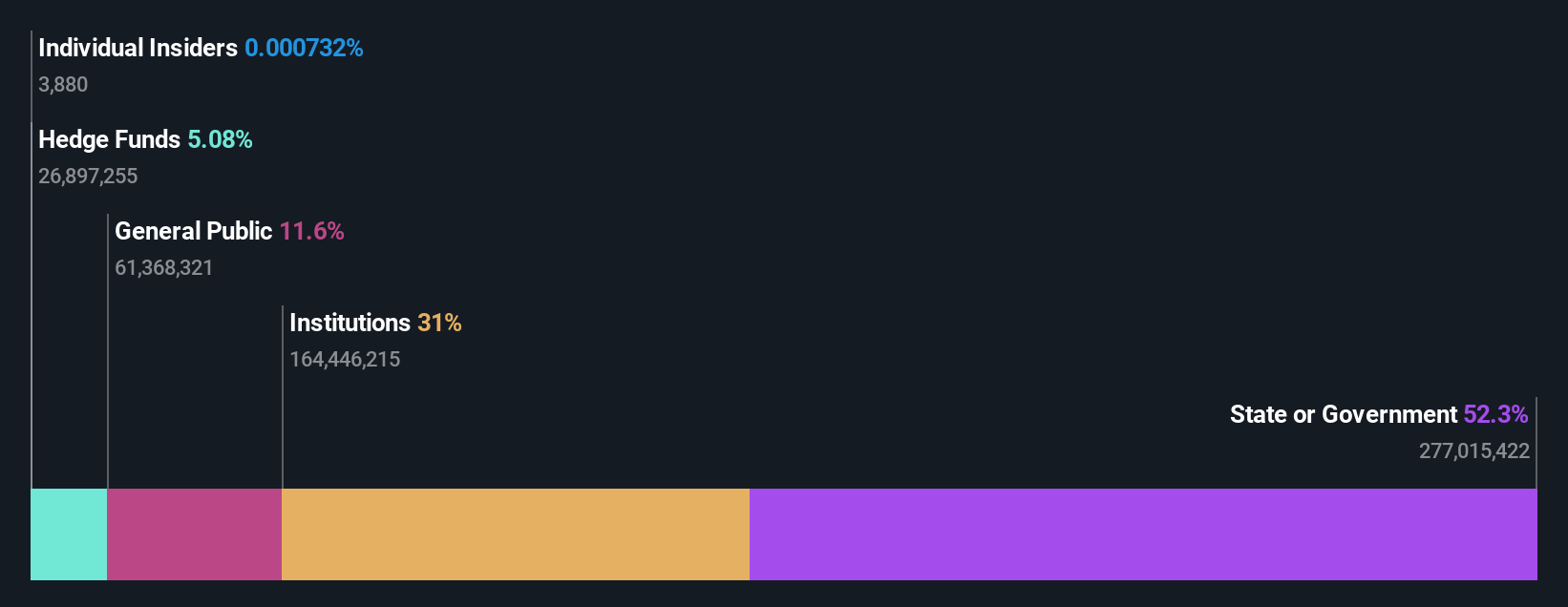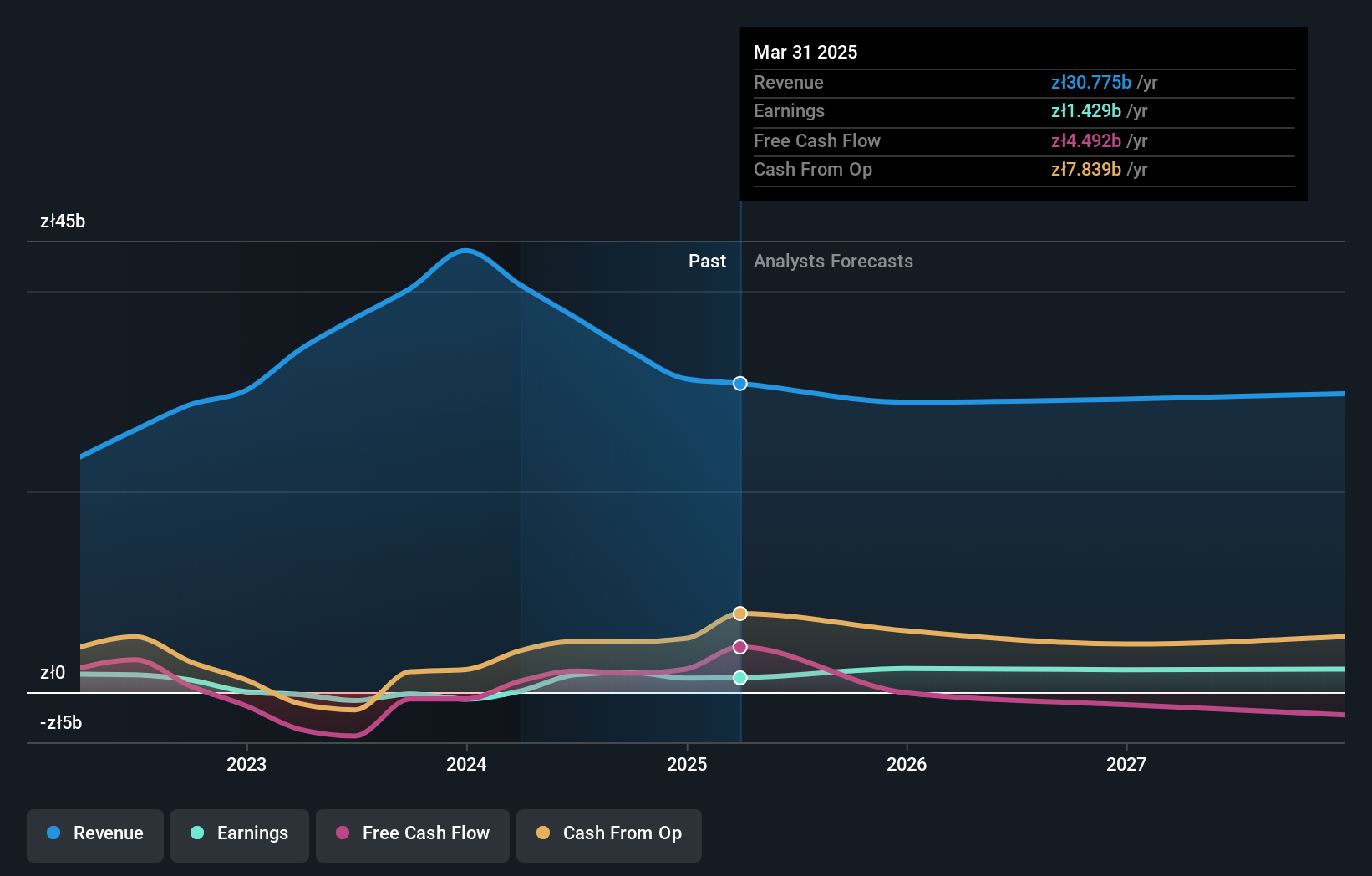- Poland
- /
- Electric Utilities
- /
- WSE:ENA
ENEA S.A.'s (WSE:ENA) largest shareholders are state or government with 52% ownership, institutions own 31%

Key Insights
- ENEA's significant state or government ownership suggests that the key decisions are influenced by shareholders from the larger public
- The State Treasury of the Republic of Poland owns 52% of the company
- 31% of ENEA is held by Institutions
To get a sense of who is truly in control of ENEA S.A. (WSE:ENA), it is important to understand the ownership structure of the business. With 52% stake, state or government possess the maximum shares in the company. In other words, the group stands to gain the most (or lose the most) from their investment into the company.
Institutions, on the other hand, account for 31% of the company's stockholders. Large companies usually have institutions as shareholders, and we usually see insiders owning shares in smaller companies.
Let's take a closer look to see what the different types of shareholders can tell us about ENEA.
See our latest analysis for ENEA

What Does The Institutional Ownership Tell Us About ENEA?
Institutions typically measure themselves against a benchmark when reporting to their own investors, so they often become more enthusiastic about a stock once it's included in a major index. We would expect most companies to have some institutions on the register, especially if they are growing.
ENEA already has institutions on the share registry. Indeed, they own a respectable stake in the company. This implies the analysts working for those institutions have looked at the stock and they like it. But just like anyone else, they could be wrong. When multiple institutions own a stock, there's always a risk that they are in a 'crowded trade'. When such a trade goes wrong, multiple parties may compete to sell stock fast. This risk is higher in a company without a history of growth. You can see ENEA's historic earnings and revenue below, but keep in mind there's always more to the story.

It looks like hedge funds own 5.1% of ENEA shares. That worth noting, since hedge funds are often quite active investors, who may try to influence management. Many want to see value creation (and a higher share price) in the short term or medium term. The company's largest shareholder is The State Treasury of the Republic of Poland, with ownership of 52%. This implies that they have majority interest control of the future of the company. Helikon Investments Limited is the second largest shareholder owning 5.1% of common stock, and Nationale-Nederlanden Powszechne Towarzystwo Emerytalne S.A. holds about 5.0% of the company stock.
While studying institutional ownership for a company can add value to your research, it is also a good practice to research analyst recommendations to get a deeper understand of a stock's expected performance. There are plenty of analysts covering the stock, so it might be worth seeing what they are forecasting, too.
Insider Ownership Of ENEA
While the precise definition of an insider can be subjective, almost everyone considers board members to be insiders. Company management run the business, but the CEO will answer to the board, even if he or she is a member of it.
I generally consider insider ownership to be a good thing. However, on some occasions it makes it more difficult for other shareholders to hold the board accountable for decisions.
Our information suggests that ENEA S.A. insiders own under 1% of the company. Keep in mind that it's a big company, and the insiders own zł78k worth of shares. The absolute value might be more important than the proportional share. Arguably, recent buying and selling is just as important to consider. You can click here to see if insiders have been buying or selling.
General Public Ownership
The general public, who are usually individual investors, hold a 12% stake in ENEA. While this size of ownership may not be enough to sway a policy decision in their favour, they can still make a collective impact on company policies.
Next Steps:
It's always worth thinking about the different groups who own shares in a company. But to understand ENEA better, we need to consider many other factors. Take risks for example - ENEA has 2 warning signs we think you should be aware of.
Ultimately the future is most important. You can access this free report on analyst forecasts for the company.
NB: Figures in this article are calculated using data from the last twelve months, which refer to the 12-month period ending on the last date of the month the financial statement is dated. This may not be consistent with full year annual report figures.
Valuation is complex, but we're here to simplify it.
Discover if ENEA might be undervalued or overvalued with our detailed analysis, featuring fair value estimates, potential risks, dividends, insider trades, and its financial condition.
Access Free AnalysisHave feedback on this article? Concerned about the content? Get in touch with us directly. Alternatively, email editorial-team (at) simplywallst.com.
This article by Simply Wall St is general in nature. We provide commentary based on historical data and analyst forecasts only using an unbiased methodology and our articles are not intended to be financial advice. It does not constitute a recommendation to buy or sell any stock, and does not take account of your objectives, or your financial situation. We aim to bring you long-term focused analysis driven by fundamental data. Note that our analysis may not factor in the latest price-sensitive company announcements or qualitative material. Simply Wall St has no position in any stocks mentioned.
About WSE:ENA
ENEA
Generates, transmits, distributes, and trades in electricity in Poland.
Flawless balance sheet with proven track record.
Similar Companies
Market Insights
Community Narratives




